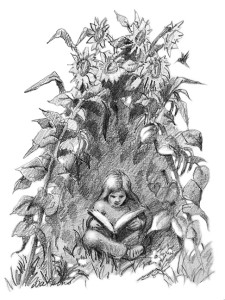Through The Garden Gate—May 2016
Getting Your Garden Back Into Shape
By Leslie Watkins

Illustration by Leslie Watkins © 2016
Here in The Icebox of Connecticut, tradition holds that our last possible frost date is Memorial Day. Global Weirding may fool us into planting out earlier, but it is better to hold off for the tender annuals like tomatoes, basil, peppers, begonias and impatiens. There is however lots to do, and plenty to plant.
Cold-tolerant peas, parsley, spinach, lettuce, radishes and all of the brassicas can be planted in early May. Pull out any leftover weeds from last year, give the soil a good turn with your garden fork, add some compost and pop in the seeds. Get your trellises and supports in now before their tender roots begin to grow. Sprinkle well with water, and voila!—your garden has begun. Just three to four weeks after planting seeds, you could be eating a home grown salad of tender young lettuce leaves, garnished with radishes. Add baby beet, mustard and arugula greens for even more nutrition, and delicious flavor.
Not ready or willing to commit to a vegetable garden? Then a seasonal container garden that can be weeded between sips of your favorite beverage may hold greater appeal. Containers filled partway with perlite, peanut shells, cork, upturned plastic pots and other bulky, lightweight items then topped with 12 to 20 inches of good soil will raise your lettuces, parsley, basil, cherry tomatoes and nasturtiums to a height that does not require much bending. Snip off lettuce leaves as needed and new ones will soon be on their way.
Get your perennial garden beds back into shape this month by dividing oversized plants and adding compost to the soil. You can increase your perennial inventory by dividing plants like hostas, daylilies and Shasta daisies. Most, but not all, perennials benefit from division at this time of year. Peonies are best divided in the fall. Lift the plants to be divided, sprinkle them with a little water and cover with a tarp to protect them from drying out. Now add compost and thoroughly rotted manure to the soil. For most soils, an inch a year of compost is fine. Add a little more if your soil is depleted. Carefully pull apart the plant to include portions of the crown and enough roots to get them off to a good start. Larger plants like daylilies may have to be sliced through with a sharp spade or pried apart with garden forks. Water deep and avoid hot, dry days to accomplish this work to prevent over-stressing them. Best to do this is in the morning or late afternoon from May through June, or in the fall when the days are cooler. Perennial plants in pots may be planted at any time with sufficient watering.
If there are young, potential gardeners in your life, help them develop their skills by growing a living “teepee” in mid-May. Start by pushing a stick into the ground in a sunny spot not far from a water source. Tie a cord to the stick and use it to trace a circle on the ground with a three- to four-foot radius. Let the kids plant giant sunflower seeds, alternating with corn seeds, using the circle line as a guide. Plant seeds about a foot and a half apart, leaving a space for the entrance. Mulch and water the seeds regularly. When the sprouts are about six inches high you can add two or three red runner bean seeds at their base to attract hummingbirds, and for healthy snacks. When the sunflowers have grown about five feet high, fasten a cord around the tops of opposite flowers to draw them together and form the roof.
May Chore Checklist
- Clean and fill hummingbird feeders.
- Put up a bluebird house.
- Set out vole traps.
- Pull garlic mustard while it’s small.
- Remove barberry while ground is soft.
- Plant a native tree or shrub.
- Water well and mulch your perennial beds.
- Leave a few dandelions for the honey bees.
- Enjoy fresh new shoots of asparagus.
- Go on a wildflower hunt in the woods.
